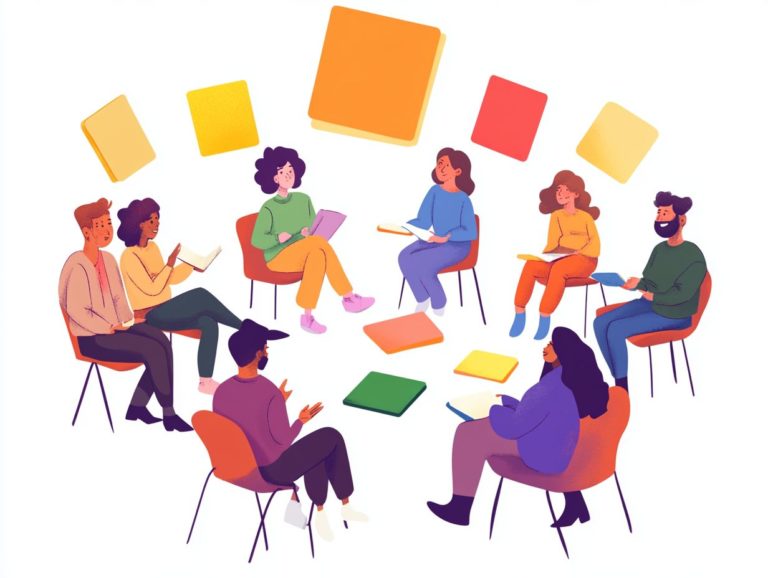the importance of understanding language nuances
Language is not just about words; it’s a vibrant blend of feelings, culture, and context!
Grasping the nuances of language is essential for effective communication. It enables you to connect on a deeper level and sidestep misunderstandings. This article explores the essence of language nuances, highlighting their significance and guiding you on how to recognize and interpret them in everyday conversations.
You ll also discover common pitfalls and gain practical tips to enhance your awareness and sensitivity. Together, let s uncover the subtleties that elevate your interactions!
Contents
- Key Takeaways:
- The Basics of Language Nuances
- Why Understanding Language Nuances is Important
- How to Recognize and Interpret Language Nuances
- Common Misunderstandings Due to Language Nuances
- Improving Your Understanding of Language Nuances
- Frequently Asked Questions
- What are language nuances and why are they important to understand?
- How can understanding language nuances improve communication?
- What are some examples of language nuances?
- Why is it important to be aware of cultural differences in language nuances?
- How can one improve their understanding of language nuances?
- What are the potential consequences of not understanding language nuances?
Key Takeaways:
- Language nuances are subtle differences in meaning, tone, and usage.
- Understanding these nuances leads to better communication and promotes cultural sensitivity.
- Listening and observation skills are essential for recognizing language nuances.

The Basics of Language Nuances
Language nuances involve intricate details and subtle differences in language that extend far beyond simple word-for-word translation. Understanding the importance of cultural nuances is crucial for effective communication, especially in a global context where cultural identity and emotional intelligence are paramount.
To understand language translation well, one must appreciate common phrases that have special meanings and the complex grammatical features that shape nuanced meanings.
Recognizing the cultural significance behind word choices and social norms will elevate your ability to convey emotions accurately, helping you sidestep potential miscommunication.
Defining Language Nuances
Language nuances refer to the subtle distinctions in meaning and expression that emerge from idioms, expressions, and the intricacies of contextual adaptation. These nuances are pivotal for effective communication, reflecting cultural values and shaping how messages are interpreted in various settings.
For example, the English phrase “kick the bucket” conveys the notion of death in a figurative sense, yet its literal translation in another language may lack the same connotation or even lead to confusion. This underscores the need for contextual adaptation in translation, ensuring that the intended meaning is preserved.
By recognizing these variations, you can help maintain the essence of the original message. This fosters mutual understanding across diverse cultures while celebrating their unique linguistic flavors.
Why Understanding Language Nuances is Important
Grasping the nuances of language is essential for effective communication, as it nurtures cultural sensitivity and inclusivity in diverse settings.
This awareness allows you to navigate the language barriers that frequently complicate global exchanges. It enables you to forge deeper emotional connections and achieve clearer interactions across various cultures.
Effective Communication

Effective communication relies on your ability to recognize and navigate the nuances of language. These subtleties often carry cultural significance that shapes how messages are interpreted.
To truly grasp these nuances, engage in active listening and demonstrate genuine interest in others’ perspectives. Approach conversations with an open mind, acknowledging the diverse contexts from which individuals originate.
Building trust can be achieved by using simple, clear language and steering clear of phrases that might confuse non-native speakers. Incorporating visual aids and practicing patience can greatly enhance comprehension, leading to more meaningful exchanges.
By fostering an environment where questions are encouraged, you create opportunities to bridge gaps in understanding. This ultimately strengthens connections and enhances collaborative efforts in cross-cultural settings.
Cultural Sensitivity and Inclusivity
Cultural sensitivity and inclusivity are vital components of effective communication. They are especially important in today s world, where mastering language is key to developing global competence.
Understanding the subtleties of language and the social norms that shape interactions allows for more meaningful engagement with individuals from various backgrounds.
For instance, recognizing that direct eye contact may be seen as respectful in some cultures but confrontational in others can elevate your interpersonal dialogues.
This awareness strengthens personal connections and enhances professional collaborations. It creates an environment where everyone feels valued and understood.
In workplaces with diversity, embracing this sensitivity leads to effective teamwork and innovative solutions. Team members can share their unique perspectives without the worry of miscommunication.
How to Recognize and Interpret Language Nuances
Recognizing and interpreting language nuances requires refining your listening and observation skills. These are essential competencies in both language education and effective communication.
Listening and Observation Skills
Listening and observation skills are crucial for understanding language nuances. They allow you to discern emotional contexts and language differences with finesse.
By honing your ability to notice subtle variations in tone, body language, and facial expressions, you gain a deeper understanding of the feelings and intentions behind spoken words.
This heightened awareness is invaluable in personal interactions and professional environments, where miscommunication can create misunderstandings.
To cultivate these skills, practice active listening techniques. Try paraphrasing what the speaker has conveyed to ensure clarity. Also, consciously pay attention to non-verbal cues during conversations.
Engaging in role-playing scenarios or attending communication workshops can sharpen these abilities, enriching your capacity for nuanced interpretation.
Common Misunderstandings Due to Language Nuances

Common misunderstandings arise from language nuances, often resulting from miscommunication. This situation can easily occur when translation challenges are not sufficiently addressed.
Examples and Solutions
Misunderstandings highlight translation challenges that emerge from failing to recognize cultural significance, leading to language barriers.
Consider this: when someone from a direct communication culture, like the United States, engages with individuals from an indirect communication culture, such as Japan, even simple phrases can become confusing.
In Japan, saying “maybe” carries substantial weight, implying that the answer is affirmative but nuanced. Conversely, in the U.S., it might be seen as evasive.
To bridge these gaps, investing in cultural awareness training proves invaluable. It helps you appreciate the subtleties and implications behind words, fostering an empathetic and informed dialogue that honors differences.
By emphasizing active listening and posing clarifying questions, you can significantly reduce misunderstandings. This boosts mutual respect and makes communication exciting!
Improving Your Understanding of Language Nuances
Enhancing your grasp of language nuances requires a thoughtful approach. Leverage a range of tips and resources to elevate your language education.
This journey blends practical applications with theoretical insights, ultimately refining your language mastery.
We encourage you to reflect on your experiences with cultural sensitivity and join workshops to enhance your communication skills.
Tips and Resources
Utilizing effective tips and resources is essential for advancing your language education. This is particularly true when collaborating with native linguists and leveraging translation software.
Engaging in conversation with native speakers can boost your confidence. It also enhances your understanding of nuanced expressions and cultural contexts.
Language exchange platforms like Tandem and HelloTalk create opportunities for you to practice speaking in a more natural and dynamic environment.
Translation software, like SDL Trados and MemoQ, can help you manage your vocabulary. They ensure consistency in your translations and simplify your workflow.
These tools also enhance your linguistic accuracy. They enable you to track your progress and streamline your learning experience, making your journey to fluency both enjoyable and efficient.
Frequently Asked Questions

What are language nuances and why are they important to understand?
Language nuances refer to the subtle and often indirect meanings of words, phrases, and expressions. They are important to understand because they can greatly impact communication, especially in cross-cultural interactions.
How can understanding language nuances improve communication?
Understanding language nuances can improve communication by allowing individuals to accurately interpret the intended meaning behind words and phrases. It can also prevent misunderstandings and conflicts that may arise from misinterpreting language.
What are some examples of language nuances?
Examples of language nuances include sarcasm, irony, idioms, and cultural-specific expressions. These nuances may have different meanings or connotations in different languages or cultures.
Why is it important to be aware of cultural differences in language nuances?
Being aware of cultural differences in language nuances is important because what may be considered polite or appropriate in one culture may be considered rude or offensive in another. This understanding can help avoid misunderstandings and foster effective communication.
How can one improve their understanding of language nuances?
One can improve their understanding of language nuances by actively listening and paying attention to the subtle meanings and tones of words and expressions. It can also be helpful to learn about different cultural customs and communication styles.
What are the potential consequences of not understanding language nuances?
Not understanding language nuances can lead to miscommunication, misunderstandings, and even conflicts in interpersonal and professional relationships. It can also hinder the development of cultural competence and limit opportunities for effective communication and collaboration.
Ready to dive deeper? Join a language exchange today and practice what you ve learned!





